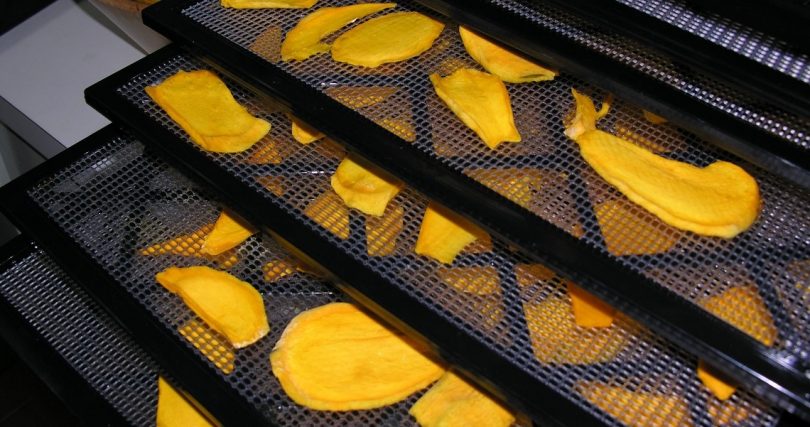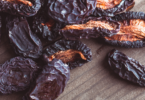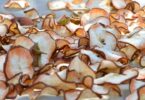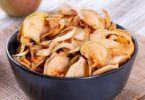Find out, how to dry mangoes at home and how to store dried mangoes properly.
In this age of modern-day conveniences, all you need to make your homemade dried mangoes are a sharp paring knife, a drying appliance, and storage containers.
Easy Methods for Drying Mangoes at Home
Choosing the right mangoes for drying
Any of the following varieties of mangoes readily available at supermarkets are good for drying. You may opt for those with firm, sweet flesh with less or no fibers:
- Honey or Ataulfo is vibrant yellow with rich and creamy firm flesh with no fibers.
- Francis has bright yellow skin with green overtones. Its fibrous flesh is sweet and spicy.
- Haden is bright red with green and yellow overtones. Its flesh with fine fibers is rich with aromatic overtones
- Keitt is dark to medium green with limited fibers. The flesh is sweet and fruity.
- Tommy Atkins has a dark-red blush with orange-yellow accents. It has mildly sweet firm flesh due to fibers throughout.
- Palmer is deep cherry red with a green background. The flesh is mildly sweet with limited fibers.
- Kent is dark green with dark red blush. Its juicy and sweet tender flesh has limited fiber.
When drying mangoes, make sure your batch came from a single variety for uniform results.
Buy 2 to 40 mangoes, depending on the number of racks on your dehydrator. If you are using an oven, 3 mangoes will cover a baking tray. Generally, 1 mango yields about a ¾ cup of dried fruit.
Pre-drying preparations
Peeling your mangoes
Wash the exterior of the mangoes first thoroughly under running water. Sometimes, mangoes can be hard to cut. Here’s how to do it so you’d minimize wastage.
If your mango is perfectly ripe, you may cut the fruit into quarters along its length. Then, pull the skin back. You may also cut each cheek off the core and slice the flesh into cubes. Then, scoop the chunks out with a spoon. The trick is to make the batch the same sizes for uniform drying.
If your mango is semi-ripe and you cannot easily pull the skin to separate it from the flesh, slice the ends off so you would have a sturdy bottom when you place it on the cutting board.
Slice away a thin layer of the peel. Slice strips, keeping the size consistent. Move around the mango until you get to the core.
Blanch the mango slices in hot water or treat them with lemon juice to reduce enzymatic browning.
Here is a tutorial video on how to blanch fruits (or vegetables).
Preparing your drying appliance
Get acquainted with your drying appliance. For example, there are 3 kinds of dehydrators: back fan, bottom fan, and top fan. Most food drying enthusiasts use back fan dehydrators for even drying.
If you don’t have a dehydrator, your oven will do just fine.
Other reminders
Don’t dehydrate mangoes with another family of foods. Although fruits could be mixed together in a single drying, it is not generally recommended, especially if the other fruits have an overpowering taste and smell.
Storage is very important for dehydrated mangoes. You may store your dried mangoes in metal containers or glass jars.
READ ALSO: How to Store Dried Fruits at Home
Drying mangoes
Drying mangoes with a food dehydrator
- Spritz your dehydrator racks with a little cooking spray.
- If you’ve picked a less sweet variety and you want your dried mangoes sweeter, mix honey and lemon juice in a small bowl. Stir until completely blended. Dip each piece into the lemon and honey mixture. Then, shake off any excess before placing them on your dehydrator racks.
- Otherwise, treat the pieces with lemon juice just to prevent browning.
- Dehydrate for 10 to 12 hours at 135°F. Check after 8 hours and flip the strips if necessary.
Store your dried mangoes in airtight containers. They should last for 3 to 6 months.
READ ALSO: Which Food Dehydrator is Right for You
Drying mangoes in the oven
- Set oven temperature to the lowest setting or at 170°F.
- Place the mango pieces on wire racks or a baking tray lined with a silicone baking sheet. Mangoes dry on wire racks faster than when placed directly on baking sheets. Mango cubes take about 6 to 12 hours to dry while thin strips take about 2 to 3 hours.
- Flip the mango pieces every 30 minutes until they appear flattened or shrunken. Dried mangoes are done when already flexible with a leather-like texture and pale orange color.
Make sure that you don’t pull the mangoes out of the oven too soon. Residual moisture may cause spoilage. To check for doneness, place a few pieces in a plastic bag. If you see condensation in the bag, return the entire batch in the oven and continue drying.
Another test is to press 2 pieces together. If they stick, continue drying.
Do usual storage.
Sun-drying mangoes
- The ideal climate for sun drying is low humidity, strong sunshine with a minimum temperature of 85°F.
- Stretch a piece of cheesecloth over a drying frame. Staple the corners to prevent the cloth from sagging.
- Blanch the pieces by steaming for about 5 minutes. Then, put them in ice-cold water. Thoroughly drain and dry the fruit.
- Arrange the pieces on the drying tray, while making sure that they don’t touch.
- You may cover the tray with a piece of glass to intensify the sun. But, leave enough space for proper air circulation.
- Place your mangoes in the sun for 2 to 4 days. Bring them in at night or when it rains to prevent them from collecting moisture.
To ensure uniform drying, you may stir the pieces after a couple of days. Then, towards the 4th day, you may place them inside paper bags. Hang the bags on a clothesline and give them a shake a few times.
Do usual storage.
Dried mango is rich in vitamin A, which keeps mucous membranes healthy for protection against bacteria and viruses. Vitamin A also promotes healthy eyes, reducing your risk of suffering from macular degeneration. Dried mangoes are also a good source of Vitamin B-complex, which converts food into energy, improves blood cell production, and relieves stress.
But, that should be the least of your motivations for making your own homemade dried mangoes because all you want really is to feast on some rich, sweet, and flavorful snack without the guilt.





